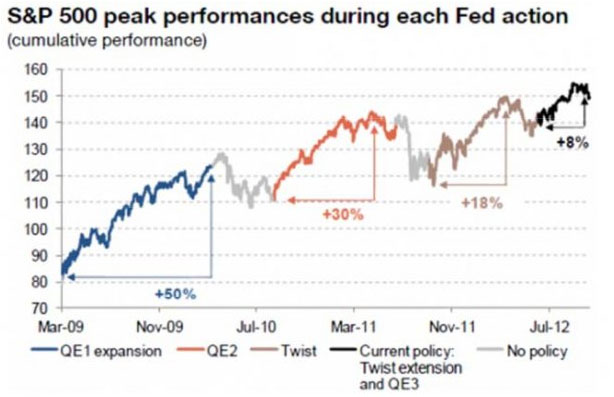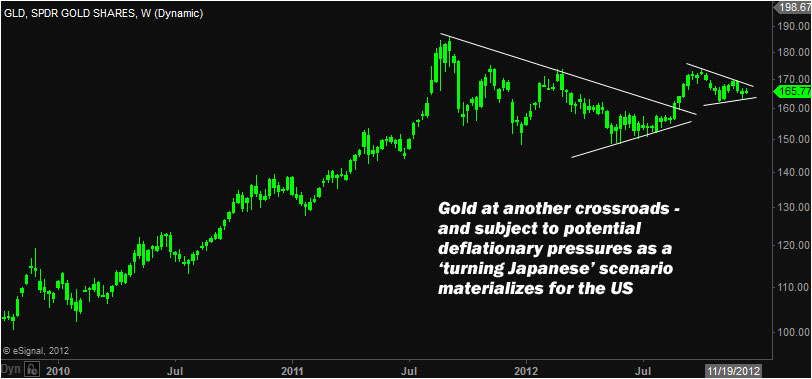In a presentation from the always thorough Jeff Gundlach, the slide posted below, “S&P 500 peak performances during each Fed action,” stood out.
The equity boosting effect of stimulus has grown smaller and smaller with each pass. This, my friends, is what we call “the law of diminishing returns.”
As we wrote in the December 13th Live Feed pre-open commentary (posted 8:27 am New York time):
S&P futures are down slightly this morning, but the heavy action is in gold, down more than $22 per ounce (129 basis points), and silver (down 91 cents or 270 basis points).
Why would gold and silver be down sharply after the Federal Reserve apparently fulfilled bulls’ wishes for bold action and “QE4?” Perhaps because a world in which interest rates are held at zero, even as austerity increases and the wealthy cut back spending, is a deflationary and gloomy one.
Bulls want to say, “Hooray, the Fed is providing more stimulus!” But the more logical interpretation is, “Wow, things are so bleak that this is what we’ve come to, even as taxes are set to rise (and government programs to be cut) no matter what happens?”
We see a significant possibility that the recent runup was almost entirely hype and hope-based… second and third level game theory in which long only money managers calculated that other managers would be buying as a result of Fed stimulus, so it was safe for them to buy too, creating a sort of self-fulfilling prophecy / virtuous circle. But the trouble with these mutually self-reinforcing cycles of belief is what happens when the drunks stop propping each other up.
A significant policy shift by the Fed is the implementation of the “Evans Rule,” after Chicago Fed governor Charles Evans, in which rates are directly tied to joblessness. For the first time, interest rates are to remain near zero until unemployment levels fall below 6.5 percent.
The questions on our minds are as follows:
- How long before markets realize the Fed is out of amunition and out of ideas?
- How long before it’s apparent the Fed has no direct ability to impact employment at all?
In August we wrote about “The Magical World of Charles Evans” — the Fed governor who has just gotten his way — to wonder, loudly, why anyone is taking this foolhardy experiment seriously. (‘Tis an experiment so devoid of objective analysis, in fact, that any scientist worth his salt would angrily deny the logic of calling it an “experiment” at all. More like a political exercise in wishful thinking.)
In a world where corporations are slashing costs with abandon, domiciling tens of billions in profits offshore, and generally finding any means they can to “maximize shareholder value” by taking it out of workers’ hides, it isn’t at all clear that unemployment can be nudged down by the Fed.
There is significant likelihood, in fact, that America’s unemployment woes are structural as much as cyclical — relating to long-term trends in globalization, demographic shifts, and corporate fat trimming that were running alongside the global financial crisis and mostly camouflaged by it. 
This is potentially bad news for gold (plus risk assets in general)… if the US economy fails to gain traction even as central banks throw everything but the kitchen sink at it, then what is to get us out of this funk?
And if monetary velocity is set to fall, not rise, in 2013, as a result of reverse wealth effect (taxes rising, government spending cuts) and stimulus diminishing, why should gold benefit?
The “inflation vs deflation” debate has never been properly settled. Gold bugs continue to make a table-pounding case that the US government is insolvent – an assertion that is logistically laughable – and further that, at some point, a monetary tsunami is going to be unleashed as a result of the Fed’s reckless juicing. Maybe someday, as far as the second assertion goes… but not today. The alternative outlook, and one significantly negative for gold, is the potential for renewed deflationary concern as all these “pushing on a string” efforts come to naught.
Under the deflationary scenario, when investors see that the emperor (Fed) has no clothes — in terms of ability to spur economic growth — and further that corporate profit margins are dangerously exposed to stimulus withdrawal, the current stage of recovery gets interpreted as a painful stretch of road in which risk assets are aggressively sold off and the USD rises.
The deflation-tinged “risk off” scenario has been fought and fought by those who have a direct stake in denying (“suppressing?”) reality – the professional optimists who constantly seek out any and every reason to be long stocks. They would be wise to remember the words of Bernard Baruch (though they never will of course):
Bulls always have been more popular than bears in this country because optimism is so strong a part of our heritage. Still, over-optimism is capable of doing more damage than pessimism since caution tends to be thrown aside.
We are heavily net short post-Fed, in anticipation of a sentiment top and an imminent return to reality-based assessment of the risk asset outlook moving forward.
Disclosure: This content is general info only, not to be taken as investment advice. Click here for disclaimer
